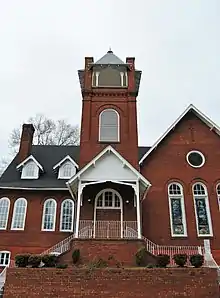Louis H. Persley
Louis "Leo" Hudson Persley (c.1888–1932),[1][2] was an American architect.[3] Persley became the first African American to register with the new Georgia State Board of Registered Architects on April 5, 1920.[1][3] He was part of what was possibly the nation’s first black architecture firm, Taylor and Persley, a partnership founded in July 1920 with Robert Robinson Taylor.[3][4][5] He had several spellings of his name including Louis Hudison Persely,[4][3] Lewis H. Persley,[6] and Louis Pursley.[7]
Louis Hudson Persley | |
|---|---|
| Born | c. 1888 Georgia, U.S. |
| Died | July 13, 1932 Macon, Georgia, U.S. |
| Burial place | Linwood Cemetery |
| Other names | Louis Hudison Persley, Lewis Persley, Louis Pursley, Leo Persley |
| Education | Lincoln University |
| Alma mater | Carnegie Institute of Technology |
| Occupation(s) | Architect, teacher |
| Years active | 1916–1932 |
Biography
Louis Persley was born and raised in Macon, Georgia, to Black parents Maxine and Thomas K. Persley.[3][7] He attended Lincoln University, and graduated from Carnegie Institute of Technology (now Carnegie Mellon University) in 1914.[3][4] He was a professor of architectural and mechanical drawing from 1915 until 1916 at Tuskegee Institute in Tuskegee, Alabama.[4][3]
In July 1920, Persely and fellow architect Robert Robinson Taylor had formed a black architecture firm together, Taylor and Persley.[4][8] This was possibly the first black architecture firm in the United States.[5] They collaborated on many designs, including of several buildings on Tuskegee Institute (now Tuskegee University) campus.
He died on July 13, 1932, at the age of 42, of kidney failure,[4][7] and he is buried at Linwood Cemetery in the Pleasant Hill neighborhood of Macon, Georgia. A historical marker commemorates him in front of the First AME Church in Athens, Georgia.[9] Persley's profile was included in the biographical dictionary African American Architects: A Biographical Dictionary, 1865–1945 (2004).
Buildings
- First African Methodist Episcopal Church (1916) in Athens, Georgia[10]
- Campbell Chapel A.M.E. Church (1920) in Americus, Georgia; listed on the National Register of Historic Places[11][12]
- Chambliss Hotel (1922), Macon, Georgia[4]
- Colored Masonic Temple (1922; or 'Most Worshipful Prince Hall Grand Lodge') in Birmingham, Alabama; for the Free and Accepted Masons[13][14][15]
- Central City Funeral Home (1928), Cotton Avenue, Macon, Georgia[4]
- Samaritan Building, Athens, Georgia (demolished)[6]
- Dinkins Memorial Building at Selma University, Selma, Alabama; with Robert Robinson Taylor[16]
- Masonic Temple in Birmingham, Alabama; with Robert Robinson Taylor[16]
- Several buildings on the campus of Tuskegee Institute, Tuskegee, Alabama; with Robert Robinson Taylor[17]
See also
- African-American architects
- McKissack and McKissack, another early Black architecture firm
References
- "Louis H. Persley (1888-1932)". Georgia Historical Society.
- Mary, Stanton (September 18, 2017). "African American Prince Hall Masons in Alabama". Encyclopedia of Alabama. Retrieved 2023-01-12.
- Wilson, Dreck Spurlock (March 2004). African American Architects: A Biographical Dictionary, 1865-1945. Routledge. pp. 443–445. ISBN 978-1-135-95629-5.
- Weiss, Ellen (2012). Robert R. Taylor and Tuskegee: An African American Architect Designs for Booker T. Washington. NewSouth Books. pp. 112, 140–142. ISBN 9781588382481.
- "History of Firsts" (PDF). Lincoln University.
- Aued, Blake (2020-11-11). "The Hot Corner and Four More Historic Athens Sites in Danger of Disappearing". Flagpole. Retrieved 2023-01-12.
- "A Macon street bears his name, but you don't know his story". Historic Macon Foundation.
- Pratt, Boyd C. (2013). "Review of Robert R. Taylor and Tuskegee: An African American Architect Designs for Booker T. Washington". Buildings & Landscapes: Journal of the Vernacular Architecture Forum. 20 (1): 136–138. doi:10.5749/buildland.20.1.0136. ISSN 1936-0886. JSTOR 10.5749/buildland.20.1.0136.
- "Bucket List: Athens and the African-American Experience". Grady Newsource. Grady College of Journalism and Mass Communication, University of Georgia. 2018-02-27. Retrieved 2023-01-12.
- Johnson, Isabella (February 28, 2021). "Athens African American History Self-guided Tour". Odssey News (magazine). Odssey Media Group. Retrieved 2023-01-12.
- Taylor, George (2011-12-29). "Campbell Chapel AME 2 Americus, GA". George Lansing Taylor Collection Main Gallery, University of North Florida.
- "Campbell Chapel AME Church". NPGallery Digital Asset Management System.
- "Birmingham: Most Worshipful Prince Hall Grand Lodge". Design200. 2019-05-24. Retrieved 2023-01-12.
- Edgemon, Erin (2017-02-26). "Birmingham civil rights landmark launches fundraiser". al. Retrieved 2023-01-12.
- "Building History: Inside the closed Masonic Temple in downtown Birmingham". The Birmingham Times. 2017-04-13. Retrieved 2023-01-12.
- Dorris, Jesse (June 1, 2020). "10 Pioneering African American Architects and the Legacy Buildings They Designed". Interior Design. ISSN 0020-5508. Retrieved 2023-01-12.
- "Tuskegee University". SAH ARCHIPEDIA. September 6, 2018.
External links
- Video: Architecture, Race and Academe from Massachusetts Institute of Technology
